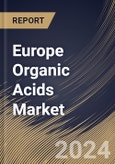The pharmaceutical industry has embraced acids for various purposes, including drug formulation, synthesis, and excipients. Adopting these acids in pharmaceuticals is driven by their unique chemical properties and compatibility with the human body. For example, salicylic acid, a type of organic acid, is a key component in producing aspirin, showcasing these compounds' critical role in medicine. The adoption of the acids in pharmaceutical applications will likely continue as the industry seeks innovative and sustainable solutions for drug development.
In chemical manufacturing, the adoption of the acids is evident in their role as fundamental building blocks for various chemical processes. Acetic acid, a widely produced organic acid, is a precursor for synthesizing polymers and other chemicals. The shift towards green chemistry and sustainable manufacturing practices has spurred interest in these acids as feedstocks. Adopting these acids in chemical manufacturing aligns with the broader industry trend towards reducing environmental impact and reliance on petrochemical-based raw materials.
According to Germany Trade and Invest, the food and beverage industry is the fourth largest industry in Germany, with a production value of 185.3 billion euros in 2020. As the demand for functional foods and beverages rises in Germany, organic acids may be incorporated into formulations to provide health benefits, contributing to developing products with added nutritional value. The growing emphasis on sustainability in the food and beverages sector aligns with using organic acids derived from renewable sources and contributes to developing more sustainable products in Germany. Expanding the food and beverages industry creates opportunities for innovation in Germany. Thus, all these factors will uplift the regional market’s expansion in the coming years.
The Germany market dominated the Europe Organic Acids Market by Country in 2022 and would continue to be a dominant market till 2030; thereby, achieving a market value of $1,629 million by 2030. The UK market is exhibiting a CAGR of 6.9% during (2023 - 2030). Additionally, The France market would experience a CAGR of 7.1% during (2023 - 2030).
Based on Application, the market is segmented into Food & Beverages, Feed, Pharmaceuticals, and Industrial. Based on Type, the market is segmented into Acetic Acid, Citric Acid, Lactic Acid, Formic Acid, Propionic Acid, Ascorbic Acid, Gluconic Acid, Fumaric Acid, Malic Acid, and Others. Based on countries, the market is segmented into Germany, UK, France, Russia, Spain, Italy, and Rest of Europe.
List of Key Companies Profiled
- Cargill, Incorporated
- BASF SE
- The Dow Chemical Company
- Archer Daniels Midland Company
- Eastman Chemical Company
- Tate & Lyle PLC
- DuPont de Nemours, Inc.
- Corbion N.V.
- Koninklijke DSM N.V.
- Celanese Corporation
Market Report Segmentation
By Application (Volume, Kilo Tonnes, USD Billion, 2019-2030)- Food & Beverages
- Feed
- Pharmaceuticals
- Industrial
- Acetic Acid
- Citric Acid
- Lactic Acid
- Formic Acid
- Propionic Acid
- Ascorbic Acid
- Gluconic Acid
- Fumaric Acid
- Malic Acid
- Others
- Germany
- UK
- France
- Russia
- Spain
- Italy
- Rest of Europe
Table of Contents
Companies Mentioned
- Cargill, Incorporated
- BASF SE
- The Dow Chemical Company
- Archer Daniels Midland Company
- Eastman Chemical Company
- Tate & Lyle PLC
- DuPont de Nemours, Inc.
- Corbion N.V.
- Koninklijke DSM N.V.
- Celanese Corporation
Methodology

LOADING...








